Cusabio Rattus norvegicus Recombinants
Recombinant Rat Calmodulin (Calm1) | CSB-EP004445RAb1
- SKU:
- CSB-EP004445RAb1
- Availability:
- 13 - 23 Working Days
Description
Recombinant Rat Calmodulin (Calm1) | CSB-EP004445RAb1 | Cusabio
Alternative Name(s): Calm, Cam, Cam1, CaMI
Gene Names: Calm1
Research Areas: Signal Transduction
Organism: Rattus norvegicus (Rat)
AA Sequence: ADQLTEEQIAEFKEAFSLFDKDGDGTITTKELGTVMRSLGQNPTEAELQDMINEVDADGNGTIDFPEFLTMMARKMKDTDSEEEIREAFRVFDKDGNGYISAAELRHVMTNLGEKLTDEEVDEMIREADIDGDGQVNYEEFVQMMTAK
Source: E.coli
Tag Info: N-terminal 10xHis-tagged and C-terminal Myc-tagged
Expression Region: 2-149aa
Sequence Info: Full Length of Mature Protein
MW: 21.7 kDa
Purity: Greater than 90% as determined by SDS-PAGE.
Relevance: Calmodulin mediates the control of a large number of enzymes, ion channels, aquaporins and other proteins through calcium-binding. Among the enzymes to be stimulated by the calmodulin-calcium complex are a number of protein kinases and phosphatases. Together with CCP110 and centrin, is involved in a genetic pathway that regulates the centrosome cycle and progression through cytokinesis. Mediates calcium-dependent inactivation of CACNA1C. Positively regulates calcium-activated potassium channel activity of KCNN2.
Reference: "Calmodulin binds to specific sequences in the cytoplasmic domain of C-CAM and down-regulates C-CAM self-association." Edlund M., Blikstad I., Obrink B. J. Biol. Chem. 271:1393-1399(1996)
Storage: The shelf life is related to many factors, storage state, buffer ingredients, storage temperature and the stability of the protein itself. Generally, the shelf life of liquid form is 6 months at -20?/-80?. The shelf life of lyophilized form is 12 months at -20?/-80?.
Notes: Repeated freezing and thawing is not recommended. Store working aliquots at 4? for up to one week.
Function: Calmodulin mediates the control of a large number of enzymes, ion channels, aquaporins and other proteins through calcium-binding. Among the enzymes to be stimulated by the calmodulin-calcium complex are a number of protein kinases and phosphatases. Together with CCP110 and centrin, is involved in a genetic pathway that regulates the centrosome cycle and progression through cytokinesis. Mediates calcium-dependent inactivation of CACNA1C. Positively regulates calcium-activated potassium channel activity of KCNN2.
Involvement in disease:
Subcellular Location: Cytoplasm, cytoskeleton, spindle, Cytoplasm, cytoskeleton, spindle pole
Protein Families: Calmodulin family
Tissue Specificity:
Paythway:
Form: Liquid or Lyophilized powder
Buffer: If the delivery form is liquid, the default storage buffer is Tris/PBS-based buffer, 5%-50% glycerol. If the delivery form is lyophilized powder, the buffer before lyophilization is Tris/PBS-based buffer, 6% Trehalose, pH 8.0.
Reconstitution: We recommend that this vial be briefly centrifuged prior to opening to bring the contents to the bottom. Please reconstitute protein in deionized sterile water to a concentration of 0.1-1.0 mg/mL.We recommend to add 5-50% of glycerol (final concentration) and aliquot for long-term storage at -20?/-80?. Our default final concentration of glycerol is 50%. Customers could use it as reference.
Uniprot ID: P0DP29
HGNC Database Link: N/A
UniGene Database Link: UniGene
KEGG Database Link: KEGG
STRING Database Link: N/A
OMIM Database Link: N/A









